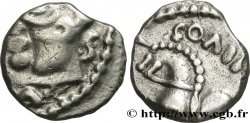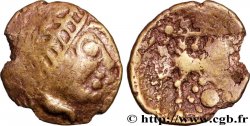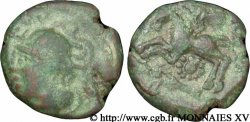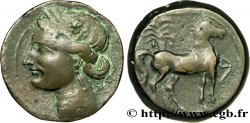v15_0946 - GALLIA BELGICA - LEUCI (Región de Toul) Bronze MATVGIINOS
MONNAIES 15 (2002)
Precio de inicio : 145.00 €
Valoración : 300.00 €
lote sin vender
Precio de inicio : 145.00 €
Valoración : 300.00 €
lote sin vender
Tipo : Bronze MATVGIINOS
Fecha: c. 60-50 AC.
Metal: bronce
Diámetro: 15 mm
Eje de acuñación: 5 h.
Peso: 3,20 g.
Grado de rareza: R1
Comentarios sobre el estado de conservación:
Monnaie de poids lourd, frappée sur un flan épais. Très beau revers aux reliefs bien nets. Légers éclatements du flan à la frappe
N° en los catálogos de referencia :
Anverso
Titulatura del anverso: [MATVGIINOS].
Descripción del anverso: Buste à gauche, tête casquée avec un cimier, torque au cou. Légende devant le visage.
Reverso
Titulatura del reverso: [MATVGIINOS].
Descripción del reverso: Cheval au galop à gauche, un oiseau posé sur le dos. Globule inscrit dans un cercle perlé sous le cheval avec un poisson au-dessous. [Légende au-dessus de l'oiseau].
Comentario
Si cet exemplaire est quasiment muet en ce qui concerne l'épigraphie, il permet de préciser le casque du droit dont le cimier semble être constitué d'esses et l'animal sous le cheval du revers. Depuis le XIXe siècle, cet animal est décrit comme étant un poisson ; sur cet exemplaire, il semble qu'il s'agisse plutôt d'un quadrupède élancé à gauche, le corps très fortement étiré. Contrairement aux exemplaires précédents, l'élément décoratif sous le cheval au revers n'est pas un annelet inscrit dans un cercle perlé mais un globule inscrit dans un cercle perlé.
Although this example is almost silent regarding epigraphy, it allows us to specify the helmet on the obverse, whose crest seems to be made up of esses, and the animal under the horse on the reverse. Since the 19th century, this animal has been described as a fish; on this example, it seems to be more of a slender quadruped on the left, with its body very strongly stretched. Unlike previous examples, the decorative element under the horse on the reverse is not an annulet inscribed in a pearled circle but a globule inscribed in a pearled circle
Although this example is almost silent regarding epigraphy, it allows us to specify the helmet on the obverse, whose crest seems to be made up of esses, and the animal under the horse on the reverse. Since the 19th century, this animal has been described as a fish; on this example, it seems to be more of a slender quadruped on the left, with its body very strongly stretched. Unlike previous examples, the decorative element under the horse on the reverse is not an annulet inscribed in a pearled circle but a globule inscribed in a pearled circle








 Informar de un error
Informar de un error Imprimir la página
Imprimir la página Comparte mi selección
Comparte mi selección Haz una pregunta
Haz una pregunta Consignar / vender
Consignar / vender
 Descriptivo
Descriptivo











